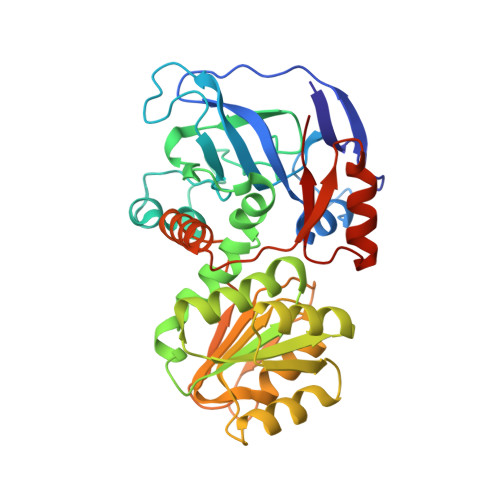Relaxation of nonproductive binding and increased rate of coenzyme release in an alcohol dehydrogenase increases turnover with a nonpreferred alcohol enantiomer.
Hamnevik, E., Enugala, T.R., Maurer, D., Ntuku, S., Oliveira, A., Dobritzsch, D., Widersten, M.(2017) FEBS J 284: 3895-3914
- PubMed: 28963762
- DOI: https://doi.org/10.1111/febs.14279
- Primary Citation of Related Structures:
5O8H, 5O8Q, 5O9D, 5O9F - PubMed Abstract:
Alcohol dehydrogenase A (ADH-A) from Rhodococcus?ruber DSM 44541 is a promising biocatalyst for redox transformations of arylsubstituted sec-alcohols and ketones. The enzyme is stereoselective in the oxidation of 1-phenylethanol with a 300-fold preference for the (S)-enantiomer. The low catalytic efficiency with (R)-1-phenylethanol has been attributed to nonproductive binding of this substrate at the active site. Aiming to modify the enantioselectivity, to rather favor the (R)-alcohol, and also test the possible involvement of nonproductive substrate binding as a mechanism in substrate discrimination, we performed directed laboratory evolution of ADH-A. Three targeted sites that contribute to the active-site cavity were exposed to saturation mutagenesis in a stepwise manner and the generated variants were selected for improved catalytic activity with (R)-1-phenylethanol. After three subsequent rounds of mutagenesis, selection and structure-function analysis of isolated ADH-A variants, we conclude: (a) W295 has a key role as a structural determinant in the discrimination between (R)- and (S)-1-phenylethanol and a W295A substitution fundamentally changes the stereoselectivity of the protein. One observable effect is a faster rate of NADH release, which changes the rate-limiting step of the catalytic cycle from coenzyme release to hydride transfer. (b) The obtained change in enantiopreference, from the (S)- to the (R)-alcohol, can be partly explained by a shift in the nonproductive substrate-binding modes. Structural data are available in the Protein Data Bank with accession codes 5o8q for A2, 5o8h for A2C2, 5o9f for A2C3, and 5o9d for A2C2B1.
Organizational Affiliation:
Department of Chemistry - BMC, Uppsala University, Sweden.


















